- Home
- Know where asbestos is
- Electrical switchboards and meters
Asbestos
Electrical switchboards and meters
Switchboard panels and meter boards may contain asbestos. If they were constructed or imported before 1 January 2004 they may contain asbestos containing materials (ACM). You can work on these, but you need to be:
- aware of the risks
- have completed a risk assessment of your work
- have implemented a risk management strategy
- follow all asbestos work and removal safe work procedures.
Examples of asbestos locations
Switchboards that were built or imported before 2004 may contain asbestos, the older the switchboard or its surroundings the more chance there is that it contains asbestos. Most switchboards installed before 1990 are very likely to contain asbestos.
Non-friable asbestos containing materials (ACM) were commonly used as an electrical insulator on meter boards and panels in general, and as bases to the busbars, spark arresters, and flash guards. Timber meter boxes installed prior to 1990 can also be lined with asbestos-cement sheeting (fibro). Asbestos dust and debris may then be present within the cabinets.
Older electrical switchboard panels and meter panels were manufactured from asbestos/resin or asbestos coal tar pitch composite. These asbestos products had brand names such as Zelemite, Lebah, Ausbestos, and Miscolite. These usually have a smooth finish on the surfaces which are dark brown to black in colour and also have a strong tar or bituminous smell to them.
Unsealed holes on these materials can reveal the presence of whitish asbestos fibres protruding from the material. Sometimes the brand names were stamped onto the rear of the boards and panels. The absence of such labels does not mean asbestos is not present.
It is not possible to tell if something has asbestos in the matrix just by looking at it (unless it is labelled or the brand names are in place). It is best to get materials tested or assume that asbestos is present and take suitable precautions and follow safe work procedures.
Common locations of asbestos within electrical installations are illustrated and described below.

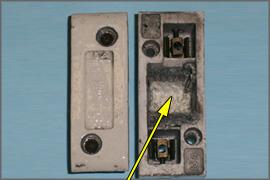
Asbestos textile wadding used in porcelain fuse holders.
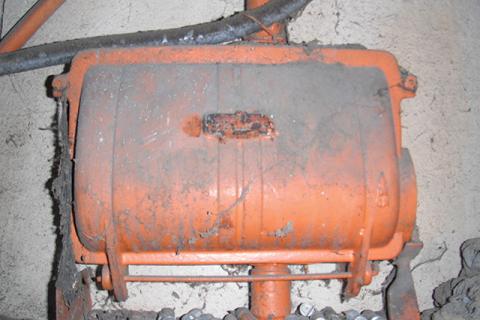
'Federal' cast-iron switch (closed state).
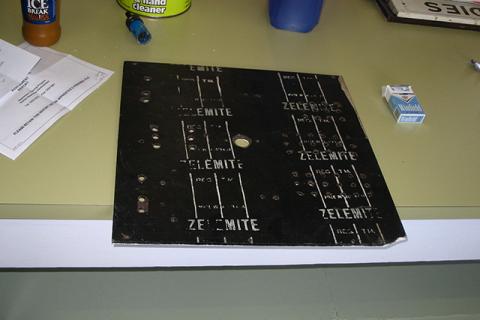
An electrical switchboard mounting board that was manufactured with asbestos.
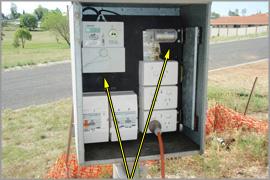
Builders pole with a metal cabinet that contains a zelemite mounting board.
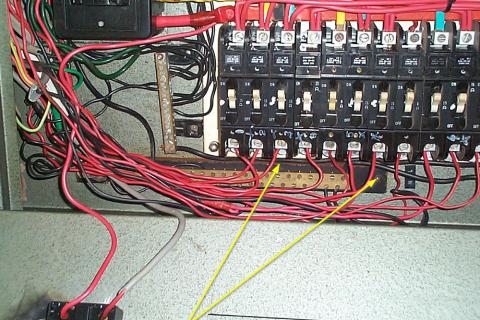
Zelemite used to insulate busbars fitted to the metal switchboard cabinet.
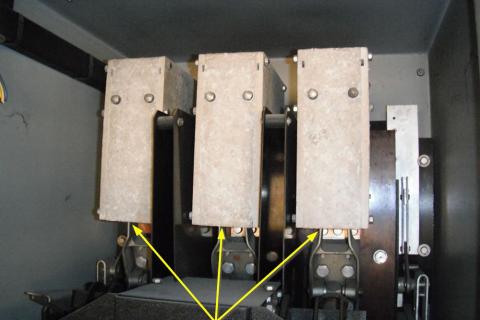
Asbestos spark arrestors or flash guards installed in a circuit breaker cabinet.
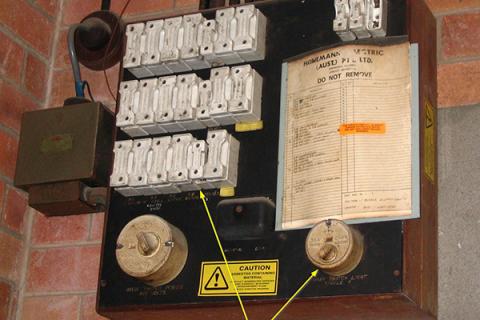
Timber-framed switchboard with a zelemite mounting board and internally lined with asbestos sheeting (Fibro).
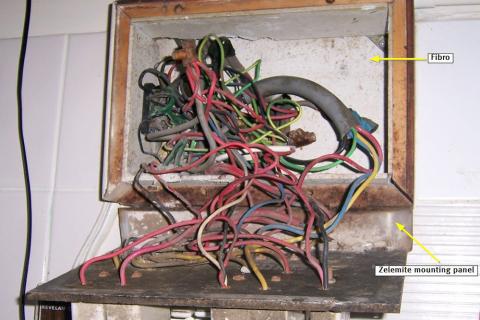
Timber-framed switchboard lined internally with asbestos sheeting (fibro) or millboard. The mounting panel is a Zelemite board.
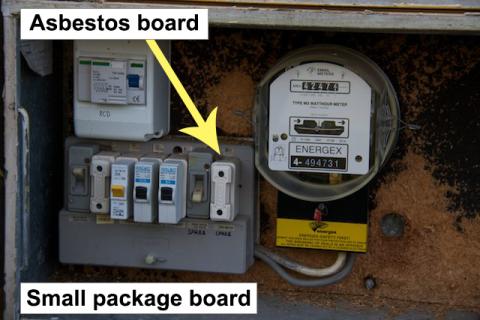
A small package board mounted over an asbestos insulation board or millboard, (white material partially visible behind the package board is the asbestos board). The asbestos board was usually nailed with clout nails or stapled to painted particle timber board.
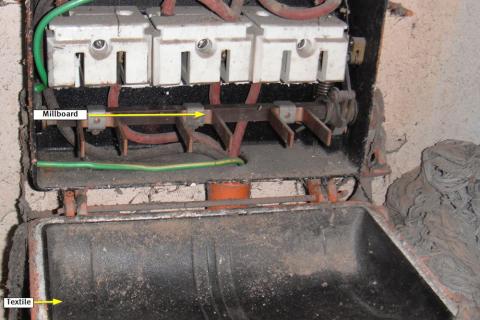
An opened 'Federal' cast-iron switch, with asbestos textile around the door edge and asbestos millboard under the ceramic contacts. Note the presence of fine dust inside the unit.
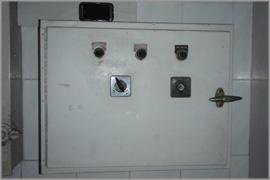
A control board cabinet.
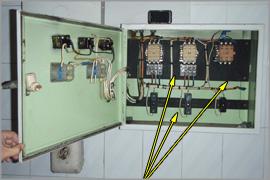
Inside a control board cabinet with Zelemite mounting boards fitted to support the circuitry.
Builders' temporary power boards
The use of temporary power boards on poles during the construction phase is a practical aspect to building. However, if the switchboard contains ACM it can only be transported for disposal purposes only. This means that older boards can no longer be re-used and must be decommissioned and safely disposed of as they can no longer be moved from site to site.
- Home
- General information
- What is asbestos?
- How was asbestos used?
- Are there health effects?
- The risks of exposure
- Health monitoring
- Legislation and codes of practice
- Low density asbestos fibre board
- Asbestos contaminated dust or debris
- Fires
- Cleaning up after floods and storms
- Importation prohibited
- Government and agency roles
- Asbestos in government assets
- Know where asbestos is
- Removing or disturbing asbestos
- Practical guidance
- Resources
- Asbestos alerts
- Asbestos news
- Codes of practice
- Guidance
- Films
- Asbestos safety session 2021
- Asbestos safety session 2020
- Cleaning Asbestos Roofs
- Shadow vacuuming with a H-Class vacuum cleaner
- Use and maintenance of a H-Class vacuum cleaner
- Identifying low density asbestos fibre board hazards and risks
- Working safely with asbestos for the home renovator
- How to properly wear personal protective equipment for airborne contaminants
- Personal protective equipment
- Dear Dad - An asbestos awareness film
- Clear and present danger: Asbestos exposed
- Uses and applications of asbestos - an extract from a film by Parsons Brinckerhoff
- Asbestos health issues - an extract from a film by Parsons Brinckerhoff
- Safe work procedure - storm and wind damage cleanup
- Drilling into asbestos walls and ceilings
- Asbestos - Removing switchboard panels
- Decontamination procedure, personal decontamination and cleanup procedures
- Asbestos awareness
- Safe work procedures
- Preparation before commencing the task
- Preparing and painting corrugated asbestos cement roof and fences
- Drilling into non-friable asbestos using a thickened substance to control airborne fibres and dust
- Drilling into non-friable ACM using an H rated industrial HEPA filter vacuum to control airborne fibres and dust
- Removing a small package electrical switchboard
- Cleanup and disposal
- Safe cleanup of storm damaged materials that may contain asbestos
- Frequently asked questions for homeowners and the general public
- Podcasts
- Strategies
- Working Safely with Asbestos Guide
- Asbestos awareness week 2025
- Asbestos management compliance campaign
- Induction and safety training for unlicensed work
- Sanctions